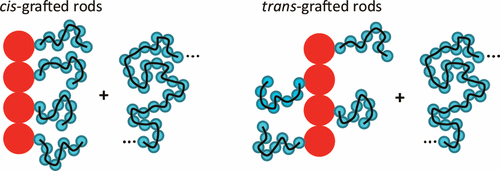当前位置:
X-MOL 学术
›
Macromolecules
›
论文详情
Our official English website, www.x-mol.net, welcomes your feedback! (Note: you will need to create a separate account there.)
Dispersion, Phase Separation, and Self-Assembly of Polymer-Grafted Nanorod Composites
Macromolecules ( IF 5.5 ) Pub Date : 2017-11-01 00:00:00 , DOI: 10.1021/acs.macromol.7b01754 Vaishnavi Gollanapalli 1 , Anirudh Manthri 1 , Uma K. Sankar 1 , Mukta Tripathy 1
Macromolecules ( IF 5.5 ) Pub Date : 2017-11-01 00:00:00 , DOI: 10.1021/acs.macromol.7b01754 Vaishnavi Gollanapalli 1 , Anirudh Manthri 1 , Uma K. Sankar 1 , Mukta Tripathy 1
Affiliation

|
A systematic understanding of the miscibility of grafted nanorods in polymer melt is required in order to synthesize materials and make devices with controllable properties. While there have been a number of studies on the effect of graft length and graft density on the miscibility of grafted nanorods, the effect of graft arrangement and nanorod geometry remains to be explored. We use integral equation theory to study the dispersion, macrophase separation, and self-assembly of sparsely grafted nanorods in polymer melt. This phase behavior is studied as a function of nanorod diameter, aspect ratio, and density as well as the length and arrangement of the polymer grafts. The phase behavior of these systems is a result of a competition between matrix-induced depletion attraction between nanorods and the steric stabilization provided by grafts. Because of steric shielding of the grafts, nanorod miscibility usually increases with graft length, and trans-grafted rods are more soluble than cis-grafted rods. Depletion attraction is stronger between larger nanorods. Therefore, shorter and thinner nanorods with longer grafts are found to microphase separate, while longer and thicker nanorods with shorter grafts tend to macrophase separate from the matrix polymer. While miscibility of bare nanorods is a monotonically decreasing function of aspect ratio, the miscibility of grafted nanorods can also be a nonmonotonic or a monotonically increasing function of aspect ratio. Grafted nanorods become less soluble in the matrix polymer as their diameter increases. Thus, the effect of rod geometry on the phase behavior of these composites is subtle and complex.
中文翻译:

聚合物接枝纳米棒复合材料的分散,相分离和自组装
为了合成材料并制造具有可控性能的设备,需要对聚合物熔体中接枝的纳米棒的可混溶性有系统的了解。尽管已经进行了许多关于接枝长度和密度对接枝纳米棒混溶性影响的研究,但接枝排列和纳米棒几何形状的影响仍有待探索。我们使用积分方程理论研究稀疏接枝的纳米棒在聚合物熔体中的分散,宏观分离和自组装。研究了该相行为与纳米棒直径,长宽比和密度以及聚合物接枝的长度和排列的关系。这些系统的相行为是纳米棒之间基质诱导的耗尽吸引与移植物提供的空间稳定之间竞争的结果。反式接枝的杆比顺式接枝的杆更易溶。较大的纳米棒之间的耗尽吸引力更强。因此,发现具有较长接枝的较短和较细的纳米棒可微相分离,而具有较短接枝的较长和较厚的纳米棒可从基质聚合物中宏观相分离。尽管裸露的纳米棒的可混溶性是长径比的单调递减函数,但接枝的纳米棒的可混溶性也可以是长宽比的非单调或单调递增的函数。接枝的纳米棒随着其直径的增加而变得不易溶于基质聚合物中。因此,杆的几何形状对这些复合材料的相行为的影响是微妙而复杂的。
更新日期:2017-11-01
中文翻译:

聚合物接枝纳米棒复合材料的分散,相分离和自组装
为了合成材料并制造具有可控性能的设备,需要对聚合物熔体中接枝的纳米棒的可混溶性有系统的了解。尽管已经进行了许多关于接枝长度和密度对接枝纳米棒混溶性影响的研究,但接枝排列和纳米棒几何形状的影响仍有待探索。我们使用积分方程理论研究稀疏接枝的纳米棒在聚合物熔体中的分散,宏观分离和自组装。研究了该相行为与纳米棒直径,长宽比和密度以及聚合物接枝的长度和排列的关系。这些系统的相行为是纳米棒之间基质诱导的耗尽吸引与移植物提供的空间稳定之间竞争的结果。反式接枝的杆比顺式接枝的杆更易溶。较大的纳米棒之间的耗尽吸引力更强。因此,发现具有较长接枝的较短和较细的纳米棒可微相分离,而具有较短接枝的较长和较厚的纳米棒可从基质聚合物中宏观相分离。尽管裸露的纳米棒的可混溶性是长径比的单调递减函数,但接枝的纳米棒的可混溶性也可以是长宽比的非单调或单调递增的函数。接枝的纳米棒随着其直径的增加而变得不易溶于基质聚合物中。因此,杆的几何形状对这些复合材料的相行为的影响是微妙而复杂的。


























 京公网安备 11010802027423号
京公网安备 11010802027423号